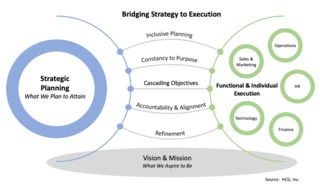Bridging Strategy to Execution
How to implement the three C's.

Imperfection in strategic planning and execution is common. Implementing simple fixes to generate desired outcomes is surprisingly uncommon.
Studies have shown that as many as 90% of well-formulated strategies fail due to poor execution. These are epic failure rates that, but for a plan to bridge strategy to tactical execution, could instead be sustainable successes. Why then do leadership teams continue to endure poor execution? Admitting that there is a problem is a good first step, followed by a decision to do something about it. However, the start is what stops most people.
My experience with strategic planning and execution within medium and large organizations echoes the poor execution performance statistics. Early in my executive career I began to discover signs indicative of meager execution. Here are a few (of many) common warning signs that strategy execution is lacking.
- The team is reactive rather than proactive.
- Every task and idea becomes a priority, and few come to fruition.
- Management arbitrarily sends out tasks to the team to keep them busy.
- Managers cannot articulate where the company will be in a year.
- The team will chase any and every opportunity to gain the revenue.
- Performance measurements, beyond revenue and profitability, are scarce.
Leadership is often united in the need for, development of, and investment in a solid strategic plan. However, in reality, there is an imbalance favoring the strategic planning process, while little effort is invested to ensure that execution protocols, alignment and tracking are in place to measure performance.
To bridge a well-formulated strategy to effective execution, proactively answer “why, what and how?” questions by following these three “C's."
Constancy to Purpose
Tying strategy to the company vision and mission will answer the critical question of “why” the team comes to work every day to perform. The people that comprise your team and company desire a sense of belonging to something special. Every motion of the organization should be aligned with your purpose for being there and the aspirations of what you want to achieve. Correlating company ethos to strategic plans of action, and doing so consistently, will solidify a clear company identity in the hearts and minds of the team.
This constancy to purpose will act as a valuable strategic guardrail to ensure that plans are within the scope of corporate strategy and vision. It also creates a “true-north” for the team that clarifies performance expectations and reinforces why the team invests their time and energy into the company.
Stay focused on and constant to the company’s purpose for being. The team members will notice and be grateful for the clarity.
Cascade Objectives Transparently
Distilling strategy into actionable steps to define “what” the team will be executing is where many plans come apart. Quite literally, this is the crucial effort that builds the information bridge to the team upon whom leadership is relying to execute the strategy. The use of spreadsheets for this practice is clunky, outdated, time-consuming and error-prone. A burgeoning segment of the software industry has designed unique, simple and affordable tools that transparently connect strategy to functional objectives and cascades these action plans to departments and individuals. Robust visuals, coupled with transparent dashboard displays track and report progress and make SaaS solutions a must to simplify this essential process.
Mid-course corrections are inevitable in the agile organization. Whether large or small corrections, digital SaaS tools easily adapt to strategic refinement. Any mid-course correction can be easily introduced and then nested within functional objectives and action plans delivering immediate roll-up reporting to management. With the adoption of digital solutions, what took days to update can be accomplished with great accuracy within minutes.
Cultivate Accountability & Alignment
Adopting digital solutions that are transparent in the execution of objectives creates the opportunity for establishing “how” the team will explicitly and implicitly be held accountable. Explicit in that departments are able to see how others are performing and how the cross-functional results are dependent upon each other. Implicit in that success breeds success and therefore stokes a company-wide sense of accomplishment. Allow all departments and individuals to achieve early wins. These wins will fan the flames of performance and perpetuate future successes.
Adjacent to accountability, establishing alignment with high-profile recognition, compensation, performance reviews and celebrations will reinforce that achieving objectives is a cultural imperative of the organization. Alignment will anchor the crucial bridging effort while attracting and retaining performance-oriented talent.
Once the three “C’s” have been implemented, leadership takes on three primary roles: impediment remover, encourager and refiner. As the teams execute on their objectives, the agile leadership team will be able to identify laggards and quickly react to remove obstacles, shore-up resources, change personnel, approve additional budget or altogether pivot direction. Encourage people, teams and departments through regular progress updates and impromptu recognitions while moving quickly to refine plans as situations and environments change. Team members will recognize leadership's agile responses to change and begin to emulate those actions within the business, effectively ending the status quo in the organization.
The practical outworking of the three “C’s” is the creation of an execution engine within the organization where functional agility becomes a force-multiplier for sustained success.
In fact, assured execution will drive more sophisticated strategies and propel growth trajectories to new heights. Leadership should no longer accept lackluster execution but rather employ these surprisingly uncommon tactics to effectively bridge strategy to execution.
